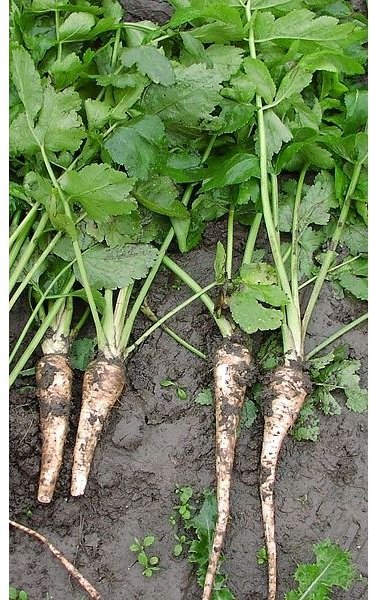Learn about the Nutrition of Parsnips
Parsnips
The parsnip is a root vegetable belonging in the same family as the carrot. They are similar to carrots but are lighter in color and stronger in flavor. Also like carrots, the nutrition of parsnips has many health benefits.
Nutrition
Parsnips are a very good source of fiber, vitamin C, potassium, and folate.
• Fiber helps keep the bowels regular, thus preventing constipation (which can keep toxins from leaving the body) and diarrhea (which can rob the body of fluids and nutrients). Fiber also regulates blood sugar levels, promotes weight loss by giving a “full feeling”, and lowers blood cholesterol levels.
• Vitamin C is a powerful antioxidant and has anti-inflammatory properties. It is necessary for the production and maintenance of collagen. Collagen is the scar tissue that heals wounds, the reinforcing structure that mends fractures, and the supporting material of capillaries. Vitamin C also protects against infections and promotes the absorption of iron.
• Potassium is critical to heart function. People who take diuretics are prone to being deficient in potassium and can benefit from including parsnips in their diet.
• Folate (also called folic acid) is essential for the formation of red and white blood cells and is especially important for women who are pregnant.
Buying
You can buy fresh parsnips in the produce section of most supermarkets. For the best nutrition and flavor, pick ones that are small to medium size (large parsnips can have a woody taste), firm, and relatively smooth and avoid ones that are spotted, limp, or shriveled.
Parsnips are winter vegetables. Temperatures near freezing is what gives them their sweet flavor. The best flavor will come from ones harvested in early spring.
Storing
Parsnips can last about 7-10 days in room temperature or in the refrigerator. Leave them unwashed until you are ready to eat or cook. If you refrigerate, place them in a perforated plastic bag.
To freeze them, cut off the tops, wash, peel (optional), and cut them into 1/2 inch cubes. Steam-blanch them for 3 minutes or water-blanch them for 2 minutes, let them cool, and place them in a suitable container made for freezing. Leave about 1/2 inch of headspace, seal tightly, label, and place in the freezer. They can keep for 10-12 months.
Cooking
Parsnips can be boiled, baked, sautéed, and steamed. In most recipes, they can replace potatoes, sweet potatoes, and carrots. They are particularly tasty when combined with other root vegetables.
To get the most nutrition of parsnips, it is best to eat them raw or lightly steamed since cooking can destroy folate. To get the most flavor, steam them with their skin on.
Sources Used
- https://www.nutritiondata.com/facts/vegetables-and-vegetable-products/2883/2
- https://www.health-care-clinic.org/vegetables/parsnip.html
- https://www.thriftyfun.com/tf98807706.tip.html
Photo Credit
Image courtesy of CC-BY-SA-3.0 / Goldlocki at Wikimedia
